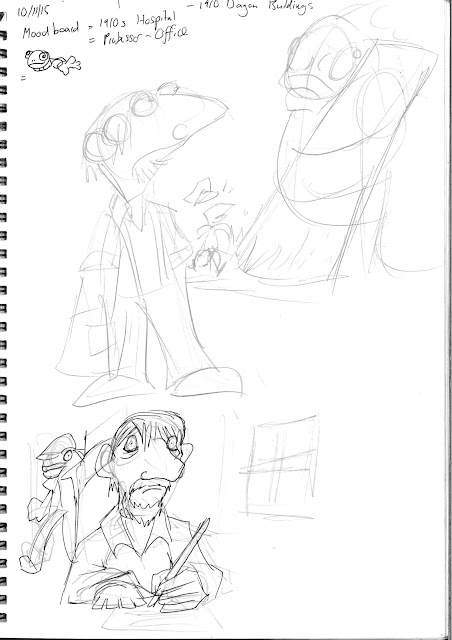Case Study 1: The Goon in Chinatown and the Mystery
of Mr. Wicker
The
Goon is a comedy, horror and violent comic series where the main character is a
goon who works for a gangster who fights off against supernatural enemies such
as the undead, ghouls and vampires. It takes place in a fictional
depression-era American town and it merges genres like horror and noir quite well.
Words and Picture
Combinations
Although the comic’s narrative includes dialogue, there are occasions where there were scenes where the story was told through the visuals.
The story was compelling and the characters were really interesting and it felt like a nice spin on the noir genre. The comic had a strong visual style inspired by noir films such as the sepia toned elements which mirrored the black and white visual style and cinematography of those particular films. While the comic series has focus on comedy, this issue takes more of a serious tone as it focuses on an important turning point for the goon's character. Throughout the comics prior to this issue, there is a reference to "Chinatown". Apparently it was a time when the goon could have had a better life. He is reunited by his lover Isabella who works for Xiang Yao. She comes to the goon for help and they spend a lot of time together. While the goon drifts out of touch with his old life, he leaves his friends and hopes to start a new life with his lover. However things fall apart as his lover leaves him for an unknown reason.
The scene that follows shows Goon looking at himself in a mirror and the next few pages is a sequence of him having an emotional and mental breakdown. It starts with a dull face but as the pages go along he begins to show more and more expressions and exaggeration. When I read this, I found this to be very effective as the sequence took up all the pages and it marked a key point in the Goon's life. It is a very heart-breaking sequence as he was very certain that with Isabella at his side, he would have a future free of crime ahead of him. It was a powerful scene because his face and gestures helped express what was going on with his head. As he breaks down, his confidence is damaged severely.
This sequence is told in a flashback. Visually this can be indicated by the way the panels are laid out and the main character has not received his trademark scar which he has in the story that is occurring during the present.
Powell felt that he did a good job as he said “I put my heart and soul into this book". (Dooley 2007). This is evident based on the content and the heart-breaking story which helps explain why the Goon is the way he is.
In figure 1, there is a montage of the Goon and Isabella spending time together while Frankie, the Goons best friend has to defend the streets himself. The first panel shows the silhouette of the goon and Isabella on a Chinese themed balcony with Chinese styled buildings in the back. There is a romantic atmosphere with the silhouettes of blossom flowing across the panel. There is also an arch which helps frame the moment. Although the background is not so detailed the silhouettes are strong and you understand that they are in love.



Figure 1. Goon Pages 50, 51 and 52 (Powell 2011)
The use of symbols represented here are some props such as the candle and wineglass. These are used to help suggest that this is a romantic dinner between the two lovers. In panel 2 on page 51, Frankie is hiding behind a crate as two gangster approach wielding guns, unaware of Frankie's location. Although they are equally spaced out, Frankie’s outnumbered by the two gangsters. Here I can see while the panel is balanced, if the goon was there this would be an even fight. However without him in the picture we can see how much Frankie needs the Goons assistance. In page 52, we see Isabella and the Goon smiling which is something he does not do very often. Meanwhile three of the panels consist of Frankie trying to fight Goon’s enemies by himself. We see the self determination on his face as he drives and shoots at the same time. We get the impression of this through the context of him trying to hold onto the territory that he and the Goon own. In panels 2 and 3 we get a moment transition (McCloud 1994) as Frankie gets punched by some gangster. This is suggested through the visual establishment of the gangsters shown in the previous page. The panels in this montage share no borders but some have a faded out white borders that makes the sequence more nostalgic and fragmented though memories. This is appropriate because these visual occur during a flashback. Furthermore the montage of the Goon having romantic moments with Isabella works really well in contrast to Frankie's moments of action. These moments show how much that the Goon is needed and that Frankie needs his friend to watch his back like they used to.
PanelsAlthough the use of words can help emphasise moments, some cases such as the Goon, do not work.
The way the panels are arranged in this sequence are effective. In the comic it starts off like a normal comic would have where the panels are juxtaposition to each other. After Isabella leaves, the panels get bigger until the scene where the Goon breaks down. The reader sees the Goons reflection in his perspective. Some of the flashback comic panels have no borders similar to the panels that occur in the present (Dawe 2014).
ColoursThe colours used in this comic's flashback sequences are very minimal, washed out and sepia toned. (PublishersWeekly.com 2007)

Figure
2. Goon page 79 (Powell
2011)
Figure
3. Goon page 80 (Powell 2011)
Goon’s posture
is now in a lower position to show that he has no control of what is happening
here.
Lighting
Figure 4.
Goon page 81 (Powell 2011)
The composition in the above comic page is effective as there is a strong contrast with the light. The way shadows cast over half of the Goons face is reminiscent to the lighting effects in the noir genre but it also suggests that the character is undergoing emotional stress. Here the Goon appears stable after Isabelle leaves, assuming that he has handled it well. His body language appears stable as he has both hands on the armrests of the chair and is sitting upright. In the second panel the door's framework acts as a frame surrounding the main focus. The negative space in panel 2 allows for a strong contrast and for Goon to act as a focal point on the panel.
Figure 5. Goon page 82 (Powell 2011)
The next page takes place in his bathroom.
There are a few props to suggest this. The transition is momentarily and shifts
close to Goon which then leads onto the next page.
Body language
The following five panels are portraits of the goon's face which fill the page.
The first panel shows the goon just staring at the mirror which in turn we see
the reflection. The white border helps the Goons silhouette stand out and the
grayscale shading helps contrasts well with the browning sepia toned
background. Furthermore
the emphasis of the facial expression is not only a breakdown of himself, he
also realises that he is unable to move on. Although Isabella's reasoning for
leaving him is vague but to him he's convinced that no woman would ever fall in
love with him again (Dawe 2014).
Figure 6. Goon page 83 (Powell 2011)
Figure 7. Goon page 84 (Powell 2011)
Here he begins to show sadness as his eyes begin to become watery. His hand covers his mouth and he’s trying to hide his expression and true thoughts of what’s happened. The wrinkle on his head begin to appear more clearly. It looks like he's trying his best to keep himself under control but he's showing weakness.

Figure 8. Goon Page 85 (Powell 2011)
This panel
continues his gradual breakdown. This time his left hand
reinforces the right hand as he tries to keep himself emotionally
under control.
Figure 9. Goon Page 86 (Powell 2010)
His two hands
now rest on his temple the fingers close
together showing that there is some attempts to
keep himself under control. His eyes have grown smaller
and his tears are now halfway down his face.
Figure 10. Goon Page 87 (Powell 2010)
In this page of this sequence, the Goons body language and gestures illustrate his frustration and the peak of his breakdown. The hands are outstretched and clutching his face desperately causing several wrinkles in his skin. Tears are now dripping down his face in multiple streams. The eyes have gotten smaller and this emphasize the expression. Dark rings are present around Goon's eyes this helps focus on his eyes. The exaggerated facial expression adds to the thought that are flowing through his head at this moment, his mouth is wider and nearly open and you can nearly see his individual teeth. Closure allows us to perceive as if it were an animated sequence.
Background
The background has lost its colour and has darkened to emphasis that he has descended into darkness where he believes there is no return. His hair is now quite mess and unkept. The best thing about this scene is that words are not necessary for this sequence. What is more important is that it was statement that the goon will never be happy. Overall, you feel very sympathetic for the Goon in this sequence and this makes it a tragic moment in the comic's series. The background lacks in detail but it allows for the reader to focus on Goon's face. The sequence takes place in the bathroom and as these rooms are a place of privacy and secrecy this is an appropriate place for him to express how he is feeling visually.
In Conclusion, The flashback visual style is appealing and the transition of bordered to border less panels in figure 1, helped reflect this. The visual language of the expression and hand gestures helped convey Goons's emotional breakdown. The panel layouts helped make the scene stand out.
Reference
Dawe, I. 2014. Comic Con Discoveries Part 1: The Goon and The Guns of Shadow Valley. [online] Sequart Organization. Available at: http://sequart.org/magazine/48739/comic-con-discoveries-part-1-the-goon-and-the-guns-of-shadow-valley/ [Accessed 17 Jan. 2016].
Dooley, C. 2007. Eric Powell’s Legacy Continues With ‘The Goon: Chinatown’. [online] Comics Alliance. Available at: http://comicsalliance.com/eric-powell-s-legacy-continues-with-the-goon-chinatown/ [Accessed 17 Jan. 2016].
Mahmoud, M. and Robinson, P. 2011. Interpreting hand-over-face gestures. 1st ed. [ebook] Cambridge: University of Cambridge. Available at: http://www.cl.cam.ac.uk/~mmam3/pub/ACII2011-Doctoral-2011.pdf [Accessed 29 Mar. 2016].
Mateu-Mestre, M. 2010. Framed Ink: Drawing and composition for visual storytellers. Culver City: Design Studio Press.
McCloud, S. (1994). Understanding comics. New York: HarperPerennial.Sims, C. 2011. The 13 Greatest Hits (and Stabbings, and Gunshots...) of THE GOON. [online] Comics Alliance. Available at: http://comicsalliance.com/the-goon-comic-best/ [Accessed 14 Feb. 2016].
Powell, E. and Stewart, D. 2010. The Goon in Chinatown and the mystery of Mr. Wicker. Milwaukie, Or.: Dark Horse Books.
PublishersWeekly.com, 2007. Fiction Book Review: The Goon: Chinatown and the Mystery of Mr. Wicker by Eric Powell, Author, Eric Powell, Illustrator . Dark Horse $19.95 (128p) ISBN 978-1-59307-833-1. [online] Available at: http://www.publishersweekly.com/978-1-59307-833-1 [Accessed 17 Jan. 2016].
























































